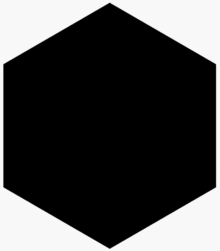Hexaflake


A hexaflake is a fractal constructed by iteratively exchanging each hexagon by a flake of seven hexagons;[1] it is a special case of the n-flake.
A hexaflake has 7n-1 hexagons in its nth iteration, each smaller by 1/3 than the hexagons in the previous iteration. Its exterior boundary is the von Koch flake, and the full boundary contains an infinite number of Koch snowflakes. The Hausdorff dimension of the hexaflake is equal to ln(7)/ln(3), approximately 1.7712. It may also be constructed by projecting the Cantor cube onto the plane orthogonal to its main diagonal.
A closely related fractal, the Sierpinski hexagon, is formed by repeatedly replacing each hexagon by six smaller hexagons, omitting the central seventh hexagon.[2] It is named after the work of Wacław Sierpiński and by analogy to the Sierpinski triangle, and has the same Koch snowflake exterior boundary as the hexaflake.
The hexaflake has been applied in the design of antennas[1] and optical fibers.[3]
See also
- List of fractals by Hausdorff dimension
- Gosper island, another fractal formed by sevenfold iteration
References
- 1 2 Choudhury, S.M.; Matin, M.A. (2012), "Effect of FSS ground plane on second iteration of hexaflake fractal patch antenna", 7th International Conference onElectrical Computer Engineering (ICECE 2012), pp. 694–697, doi:10.1109/ICECE.2012.6471645.
- ↑ Devaney, Robert L. (November 2004), "Chaos rules!" (PDF), Math Horizons: 11–13.
- ↑ Lai, Zheng-Xuan (2012), Self-similar optical fibers, Ph.D. thesis, Syracuse University, L. C. Smith College of Electrical Engineering and Computer Science.